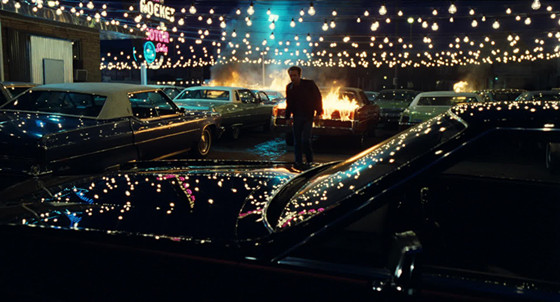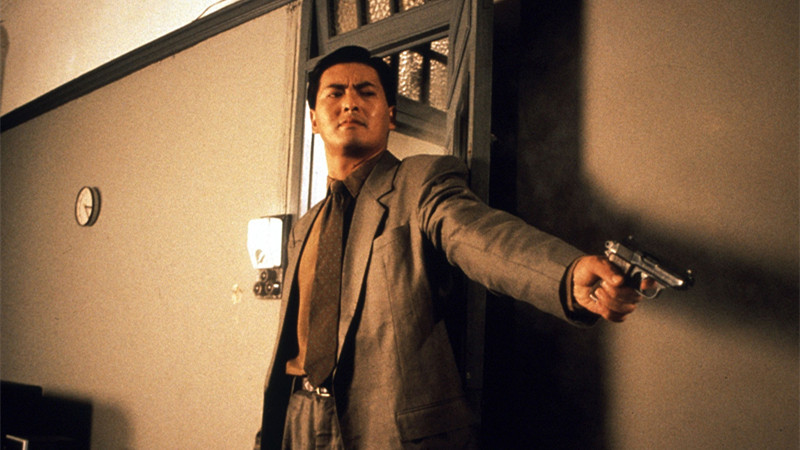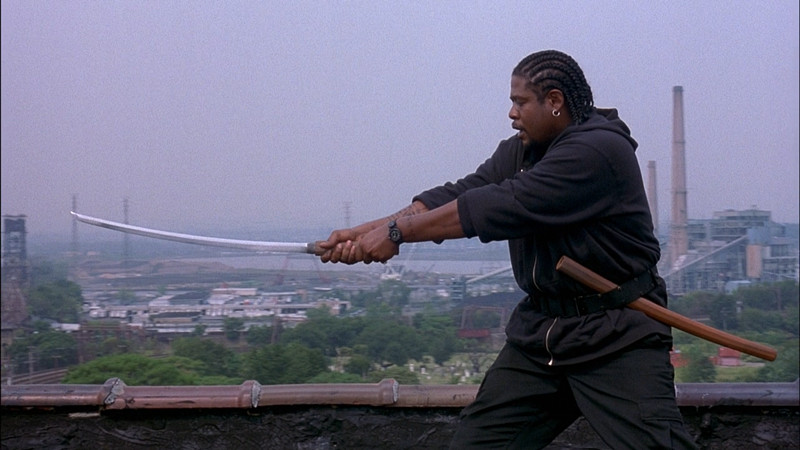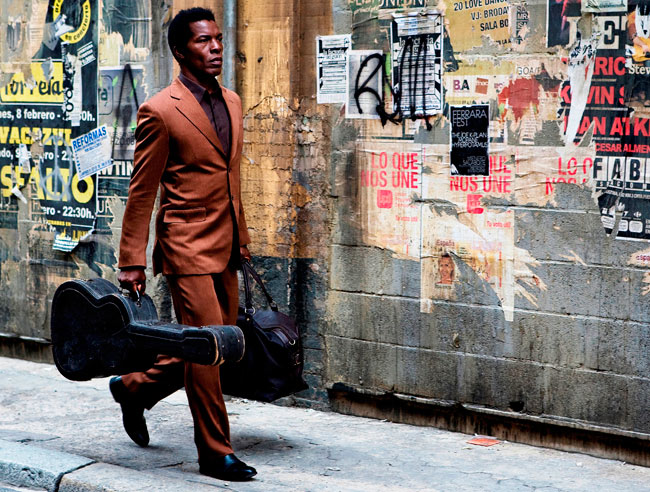6. Thief (1981)

Director Michael Mann, probably best known for his work on the 1980’s police series Miami Vice and the 1995 bank robbery film Heat made his name much earlier with the now beloved James Caan vehicle Thief.
Frank, an ex-con who lost his twenties to a stint in prison emerges with a mind set on making up for lost time as a used car salesman by day and thief by night, chasing an American dream all his own for a house, a wife, and child. A product of inhuman institutions, from the impersonal rearing of an orphanage to the kill or be killed world of prison, Frank is an antisocial man in a world reduced to the barest rules of survival and animal competition. He is a thief because there is nothing else left for him – he has no personality outside work and there is no work fit for him but taking.
We join him at the start of the film in the middle of his latest diamond heist, a small safe in the backroom of a small business – a low key operation that he can hit without raising alarms and pay his way. But after his fence (Hal Frank) is murdered and Frank pursues those who took his merchandise before it made it to market he finds his way to the city’s leading syndicate, headed by Leo (Robert Prosky), an admirer of Frank’s work who wants to offer him a big job, a diamond heist that would let him retire. But Frank doesn’t like the attention this job would attract, the cooperation it would require with the corrupt police, and he doesn’t like the patronizing way Leo talks to him or the controlling way Leo runs his operation, but wanting to buy his new girlfriend Jessie (Tuesday Weld) a new life he reluctantly agrees. Leo provides. And as Frank plans the heist with his new team he moves himself and Jessie into a new house, with a new adopted baby boy. But it becomes clear Frank and Leo will not be long time partners, that Leo demands more of Frank than he is willing to offer, and that in the fallout of the heist Frank is going to have to enact a bloody separation.
The film’s heist scenes here are terrific, tense, convincing, meticulous, unintuitive, and technical – burning into a vault with a six thousand degree welding lance – and we see as much of the preparation as the thing itself, a real sense of process. Scored by Tangerine Dream in its most intense moments, the film in its moody neon night photography achieves a rare genre magic.
7. The Killer (1989)

In John Woo’s retelling of Le Samourai killer Jeff becomes hitman Ah Jong (Chow Yun Fat, and in the English dub “Jeffery”) who in the firefight that ensues killing a club owner, accidentally blinds lounge singer Jennie, (Taiwanese pop singer Sally Yeh) searing her cornea when he fires a gun a little too close to her face and becomes in time her guilty benefactor, unbeknownst to Jennie, and works in tragic order to pay for her cornea replacement surgery which will reveal his identity to her.
Taking one final hit on a politician who will be making an appearance at a boat race, Ah Jong is betrayed by his Triad handler Fung Sei (Chu Kong) on orders to kill Ah Jong rather than let him retire, while meanwhile the young detective Li Yang (Danny Lee) begins to closely pursue Ah Jong in a crusade against the Triad after the death of his partner. But Ah Jong earns the respect of Li Ying after a young girl is hit by Triad crossfire following Jong’s hit and risking his own life and capture, takes her to a hospital rather than get away. And on further meetings, and the constant thwartings of Li Ying’s attempts to capture Ah Jong, this respect grows into a partnership and even a friendship when they are forced to work together against the Triad.
In this John Woo brings Le Samourai into his Hong Kong action style, – Woo’s signature uses of slow motion, constant cross-cutting, massive muzzleflahses, blood squibs, explosions, inexplicable indoor flocks of birds, and acrobatic gun-fu – creating a new popular archetype and form in the crime thriller genre to be continued in action films like Leon The Professional (1994) and The Ronin (1998) each as influenced by Le Samourai as The Killer in their own way, and paving the way for blockbuster heroes like John Wick.
8. Ghost Dog: The Way of The Samurai (1999)

Jim Jarmusch’s 1999 Ghost Dog: The Way of the Samurai transposes Melville’s story to a hip-hop infused NYC, where Forest Whitaker’s Ghost Dog practices the bushido code in his work as assassin for the Italian mob, the film punctuated by his recitation of passages from the Hagakure or ‘book of the Samurai’.
Ghost Dog lives as a perfection of the warrior code, and kills for the mob on contract out of an eternal debt to the mafioso Louie (John Tormey) who saved his life when he was young – being beaten in an alley by a gang of whites who Louie stopped to step in on. Now contracts out his services to select clients by carrier pigeon, pulls off jobs without ever meeting those he works for, and without leaving a trace behind. He is something of a local legend, and overhears one day, a group of rappers freestyling about him in the park.
Hitting a made mobster Handsome Frank (Richard Portnow) but leaving Louise (Tricia Vessey) the daughter of underboss Ray Vargo (Henry Silva) alive – for whom he had no contract – it is determined Ghost Dog flubbed the hit, and must be eliminated. So Ghost Dog goes to war. And the mob – portrayed as relics, aging, incompetent, and ineffectual, prove little threat to the professional ways of Ghost Dog.
Between the expected scenes of hitman action, we see Ghost Dog form a friendship with Pearline (Camille Winbush) a young girl from his building with whom he shares an interest in the books she carries with her in a lunchbox, – among them The Souls of Black Folk and Frankenstein – giving her a copy of Rashomon by Ryūnosuke Akutagawa, that classic work of subjective reality taken from Louise Vargo on the night of Handsome Frank’s hit. Meanwhile Ghost Dog’s only other relation is the French-speaking ice cream truck driver Raymond (Isaach de Bankolé), neither of which seem to mind the mutual language barrier.
The film scored by RZA of the Wu Tang Clan – who makes a brief cameo appearance – explores an aesthetic merger between East and West found in Wu Tang lyrics that extol a samurai code in the ways of New York City street life.
9. The Limits of Control (2009)

And as Jarmusch remade Le Samourai in Ghost Dog he would a decade later he would recreate Point Blank “by way of [French director] Jacques Rivette”, set it in sunny Madrid, Seville, and Almeria in a slow burn abstraction of the loner crime thriller.
A man in a suit with principles and mercenary purpose. Here the hitman is played by a sharp dressed mostly silent Isaach De Bankolé. He practices Tai Chi and refuses to carry a gun. A foreigner in Spain he belongs to an international network whose nature suggests both hired killers and the quietly forming foundation of some intellectual revolution. The film is the course of his mission, its preparation and execution but central is the tension of not knowing what that mission is, and one begins to wonder if the man himself knows. The Limits of Control becomes an enigmatic riddle of a procedural. A procedural sure, but of what?
The film unfolds with Bankolé‘s deliberate pace, moving through the streets and gathering information from a succession of contacts hidden in plain sight. Each of the contacts (including John Hurt and Tilda Swinton) appear as if stepping out of different films, offer the protagonist a coded matchbox and a cryptic monologue, each riding the line of empty small talk and esoteric insight like some great revelation waits just outside of comprehension. At times they seem even aware of the fact of their existing in a film. Slowly, the nameless force of the opposition begins to materialize in the form of black helicopters and counter operatives stalking the protagonist and his co-conspirators through the labyrinth of narrow streets. It is a game of spies, though the rules are never explained.
There seems to be an allegory at work. As the title suggests it may well be a battle between expression and control. And yet the would-be agents of expression act with a samurai-like order in their battle with control. Is this political allegory? Is it psycho-spiritual?
Whether there is a code to crack or not, what remains from The Limits of Control is the sense of something experienced, the dream of a genre at rest told in gestures, cliches, and callbacks, all but emptied of meaning, a man in a suit with something sinister in his briefcase, a kidnapping, a code, diamonds – a love letter to films of a bygone time and a whittling of the genre form down to its barest metaphysical nub. And it is to Jarmusch’s credit as a formalist that this never becomes boring, never veers too far into the avant-garde and maintains its atmosphere of mystery and danger.
10. Drive (2011)

Propelling Danish arthouse favorite Nicolas Winding Refn to mainstream international fame 2011’s Drive was not only a turning point for the director but also for the decade in film more broadly. Riding the crest of certain retro/synthwave stylings in commercial art and filmmaking.
Ryan Gosling stars as an unnamed and withdrawn Hollywood stunt driver and mechanic moonlighting as a getaway driver where he is among the best of his class and works with a strict set of rules including a five minute window on either side of which he has no contact with or responsibility to his clients.
The driver’s life is mostly simple, devoted to work under the owner of his garage and manager Shannon (Bryan Cranston), and the maintenance of his car. But things change when he gets a new next door neighbor, the single mother Irene (Carrey Mulligan) and her son Benecio (Kaden Loss) with whom he quickly forms a reserved sort of bond, playing the role of father to Beneicio – only for her husband Standard (Oscar Isaac) to be suddenly released from jail.
Standard is not so receptive of the driver, until finding himself in trouble with mob debtors to whom he owes prison protection money, and enlists the driver to help get his family out of debt. It’s a simple job Standard has for him – they always are, aren’t they? – a quick pawn shop hit to put everything behind them. But the robbery goes wrong, they find they’ve been set up, and the shop yields way more money than any East LA pawnshop is supposed to have. With a trail of bodies and a bag of who knows whose money the driver must use his skills to try and square things before vengeance descends on those he cares about most.
With its heightened ethereal cool giving way to bursts of controlled action and brutal violence and scored by Carter Burwell’s graceful ambience and the now iconic synthwave tracks “Nightcall” by Kavinsky and College & Electric Youth’s “A Real Hero” the film created a stylistic landscape all its own whose influence could be felt throughout film of most of the following decade, setting a new standard for indie-art cinematography and pacing, and creating a new iconography of cool to transcend the medium.